The beauty of Macedonia! [PART TWO]
 •
by
•
by DarkoDimovski1

The Great Mother
The artifact dates from 5800-5200 BC. It is a sacrificial object, excavated at the well-known archeological locality called Tumba(Mound) in the vicinity of the eastern suburbs of Skopje. The sacrificial object is made in the form of female figure, the goddess of fertility, and is the only such object found in the Balkans from the Neolit period. The most intriguing is the duality of the shape. The upper part depicts a female figure, whereas the lower part is in the form of an architectonically shaped hollow pedestal.
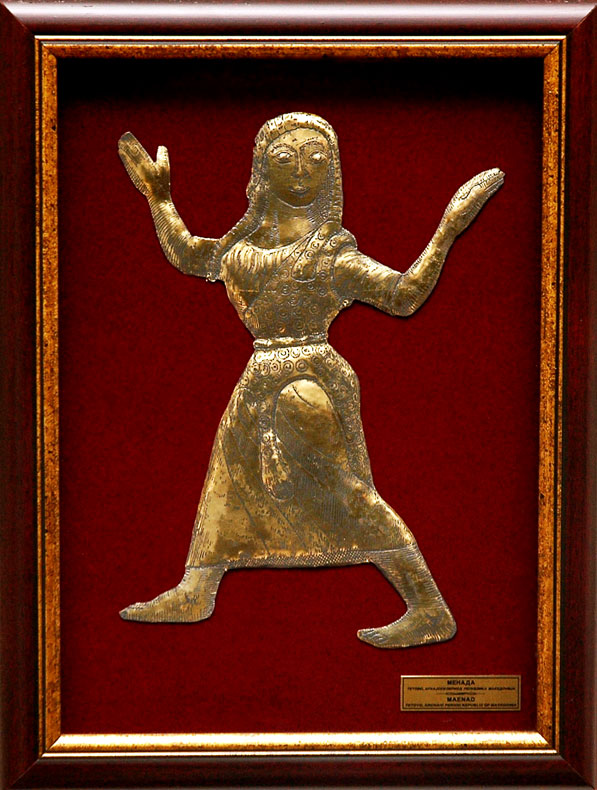
The Maenad
The so-called Tetovo Maenad dates from the 6-5 century BC. It depicts a female votary dancing frenziedly in worship of Dionysis, God of wine and vegetation. It is a bronze figure which is belived to have been an ornament placed on a large bronze vessel. Its style suggests the beggining of the period of classical antiquity.

Golden Burial Mask
It is a major archaeological discovery dating from the 5century BC. It bears witness to the ancient burial rites in the Lychnidus necropolis. It had been used along with a golden glove and a ring found together with the mask in the locality of Samuel's Fortress (Upper Gate) in Ohrid. Judging by its characteristics, it belonged to the ancient Macedonian people.
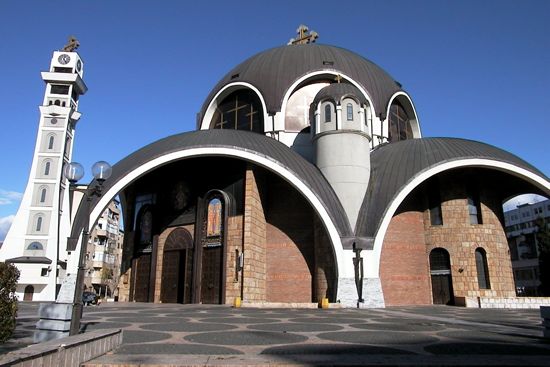
The church of the Holy Saviour
The iconostasis was made in the period of 1819-1824, and is recognised as a masterpiece of the Mijak wood-carving master Petre Filipovski-Garkata, Makarie Frchkovski of Galichnik and Marko of Gori. The iconostasis presents biblical scenes, flora and fauna, and various geometrical structures and shapes. It is 10m long and 4.5m high.

The Cave Church of St. Archangel Michael
It is located in the natural caves above the western shore of Lake Ohrid near the village of Radozda in the vicinity of the city of Struga. It is dedicated the the leader of the Celestial warriors, The Archangel Michael. The majority of the fresko paintings dates from the 14century and are regarded as being among the best examples of the Ohrid painting school. The most valuable fresco, however, is the 13century Miracle in Cana of Galilee.

Marko's Monastery
It dates from the 14century and is located near the village of Sushtitsa in the Skopje vicinity. The church is dedicated to St. Demetrius and, according to the inscription above the entrance, it was restored by King Volkashin, and later by his Son Prince Marko, between 1366-1377.

St.Panteleimon Monastery
The monastery was build in 1164 and was dedicated to the patron saint of health. It was build by Prince Alexius. The monastery is in the shape of a cross in a rectangular space with five domes: one large octuble dome, and four small quadruple domes. In the course of his existence this church has suffered many misfortunes (fires, earthqueakes, damage, theft etc), but it is still one of the most well-preserved monuments from the 12 Century.It's frescos display the first traces of the new Renaissance art, about 140 years before the appereance of the great painter Giotto, the first Renaissance painter.

The Mustapha Pasha Mosque
One of the most beautiful examples of Islamic monuments from the 15 century in Skopje. It stands above the Old City's market place and was build in 1492 by the military ruler of Skopje, Mustapha Pasha. The city of the Mustapha Pasha Mosque consists of a mosque, a tomb(turbeh), a sarchophagus of his daughter Umi, a water fouintain, several tombstones and remnants of an imaret and a madrasah.

The Daut Pasha Bath
A monument of the Islamic profane architecture from the 15 century. In the past, this object had been used as a bath and sauna. Since 1948 it has been turned into a Macedonian National Art Gallery with a permanent comptentorary art exhibition.
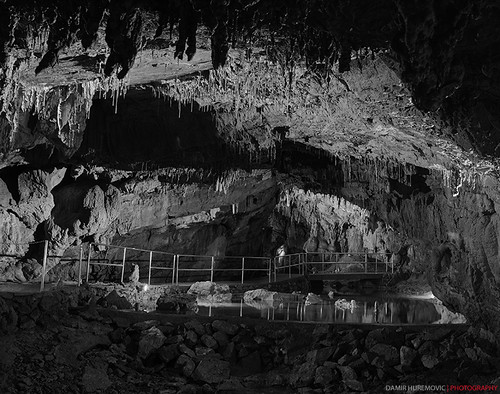
The Vrelo Cave
This cave is a part of the speleological complex of Matka, which consists of three major caves; The Vrelo Cave, The Beautiful Cave, and the Baptistery. The Vrelo Cave abounds in stalactites and stalagmites, with rounded soft shapes that spread along the whole of the ceiling. Their white surface is spotted with red and yellow designs embedded in the geomorphic structure of the roch, having been created in the course of the millenia. It takes a lifetime for one calcite drop to solidify. In the depths of the cave there is two lakes, the Large and the Small Lake. The cave have been listed as a candidate for the new Seven Wonders of the World.

Debar Lake
The real name of the lake is Shpilye, a man-made lake build in 1967 for the needs of a hydroelectric plant. It's the second largest man-made lake in the Republic of Macedonia, located among the forested areas of western Macedonia, near the city of Debar.
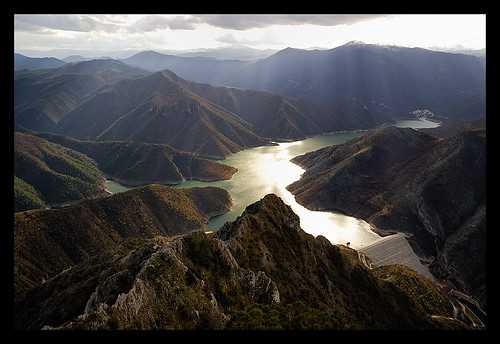
Kozjak
The man-made lake of Kozjak is located along the Treska canyon, about 30km from Skopje. The dam is 126m high and is on of the highest in Europe. The lake is located at an altitude of 300m and is 32km long and 130m deep. It abounds in various kinds of fish.

Korab Mountain
The Korab mountain streches along the border between Macedonia and Albania. It has been the highest peak in the country, Golem Korab, at 2,764m.

Lazaropole
This is a beautiful Mijak Village nested in the bosom of the Bistra Mountain at an alatitude of 1350m. As the old people say, it is five hours of horseback from the city of Debar. The first mention of village is in the so-called Kodika book - a book of donors to the Slepche monastery from the second half of the 15 century. It has wonderful examples of old traditional architecture, houses build of stone that resembe medieval fortresses. On of the most famous houses in the village is that of Gjurcin Kokale(1755-1863),the benefactor of the church St.George, also known as a legendary hero and protector of his people. This village has been the birthplace of many famous personalities from the Macedonian cultural and historical past: prists, poets, academicians, artists, master builders. The beautiful natural enviroment in its vicinity attracts a number of visitors to this village.
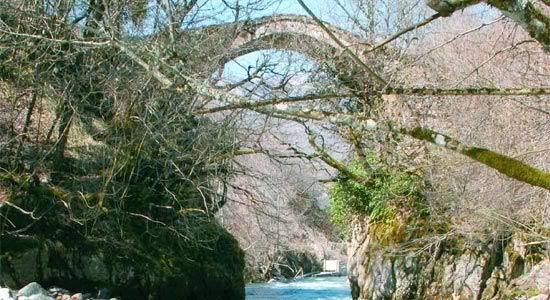
The Deer's leap
It received its name after the very elegant arch that leaps from one bank of the river to the other. In the past the bridge was a favorite meeting place of lovers.
If you liked this please shout:
The Beauty of Macedonia! [PART TWO]
http://tinyurl.com/3nd3ceq


Comments
Глас бре : )
За наредниот трет дел стави слики од природните убавини на Егејска Македонија, Пирин, Преспа и Голо Брдо
МнМ о7
bravo interesno
Топ статитја!
о7 браво !
о7 браво !
amazing...
greetings from Turkiye!
o/
http://www.erepublik.com/en/newspaper/crazystaff-255727/1
sub 😃
o7
v
Прекрасно
o7
o7
o7
o/
o/
http://miburl.com/cWWfiM
ДЕЛЕЊЕ ЛЕБ
nice article
v 105
s 1464
sub me back please
http://www.erepublik.com/es/article/-mineduc-el-gold-en-erep-blik-1797286/1/20
bravo
о7
о7
o7
o7
o7
Ivan Vancho Makedonski
Айде за Пирин не бери грижа не ви засяга вас иначе вот за статията нещо различно и интересно
the mask is in greece and its from agamemnon
http://en.wikipedia.org/wiki/Agamemnon
look the right picture
woooooooooooooooooooooooooooooooow 😮 ! 😮 ! 😮 ! really? come to greece για να την βρεις ...
the ancient macedonian people have never inhabited the area of vardar macedonia. it's typical thracian mask.
the great mother is thracian as well
thracian
that mask is at greek musuem and its Agamemnon's mask
visit Greece and see it by yourself 🙂
http://tinyurl.com/5r2uaos
Welcome Greeks!
💜💙💚🧡❤️💛 https://www.youtube.com/redirect?q=%6e%61%6b%65%64%2d%67%69%72%6c%73%2e%6f%6e%6c%69%6e%65%2f%6b%6b%2f%78%6b%44%57%43%39%3f%73%6f%75%72%63%65%3d%65%72%65%70%75%62%6c%69%6b%26%61%64%5f%63%61%6d%70%61%69%67%6e%5f%69%64%3d1796959